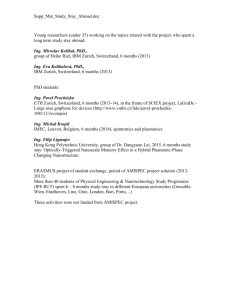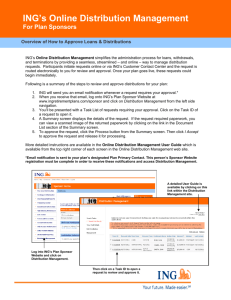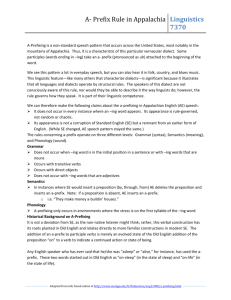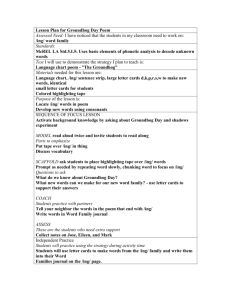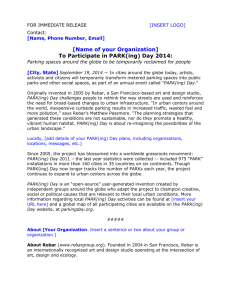ING Real Estate Property Funds Tax Guide 2009
advertisement
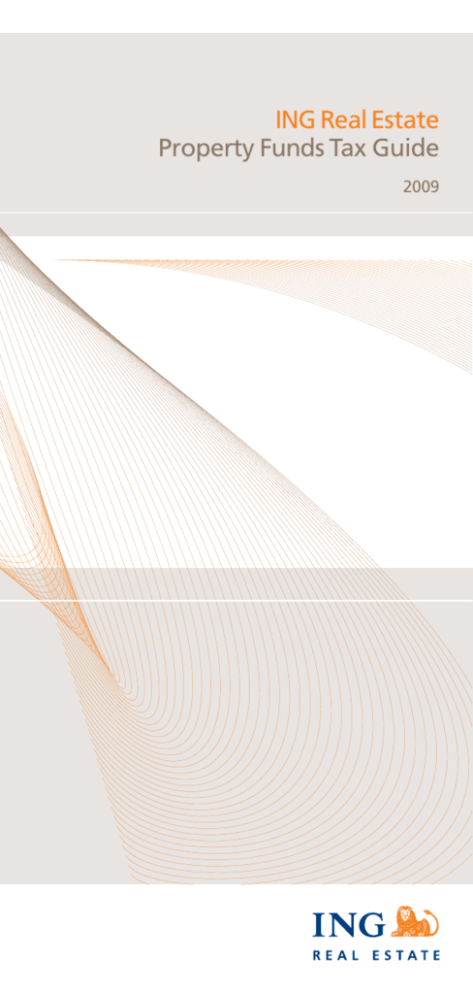
ING Real Estate Property Funds Tax Guide 2009 Contents 1 1.0:About this Guide 1 2.0: Completing 2009 income tax returns 2 3.0:Details of annual distributions and their taxation treatment 3 3.1:Australian taxable income 3 3.2: Foreign taxable income 4 3.3:Attributed foreign income (“CFC”) 5 3.4:Discounted capital gains 6 3.5: CGT discount amount 6 3.6:Other taxable capital gains 7 3.7:TAP and NTAP capital gains 7 3.8:Tax deferred income 8 3.9: Franked dividends 9 3.10:Unfranked dividends 9 3.11:Tax file number withholding tax 10 4.0:Other important information for investors in specific ING Property Funds 10 4.1: Investors in ING Office Fund (“IOF”) 10 4.2: Investors in ING Real Estate Community Living Group (“ILF”) 11 4.3:Investors that have disposed of securities during the 2009 financial year 11 5.0: Frequently asked questions 12 6.0:Other information 13Annexure A – ING Property Funds ING real estate Property Funds Tax Guide 2009 1.0 About this Guide This Guide is relevant to you for the income year ended 30 June 2009 if: >you are an Australian resident individual investor in one or more of the ING Property Funds (refer list at Annexure A); and >you hold your investment in the relevant ING Property Fund as a capital investment and not for the purposes of resale at a profit so that the capital gains tax (“CGT”) provisions are relevant to you. This Guide has been prepared for general information only and to provide further explanation of information disclosed in investors’ Annual Taxation Statements for the relevant ING Property Fund. It is not, nor should it be relied upon as, tax advice or financial product advice. Each investor’s circumstances will invariably differ and each investor should consider seeking independent tax advice relevant to their own particular circumstances. 2.0 Completing 2009 income tax returns The Annual Taxation Statement for the relevant ING Property Fund will set out the disclosures likely to be relevant for the completion of each resident individual investor’s 2009 income tax return. Any income or capital gains that investors have derived from other sources should be added to the relevant amounts received from an ING Property Fund and the total amount for each category should be included in the investor’s 2009 income tax return. 1 3.0 Details of annual distributions and their taxation treatment Distributions from ING Property Funds will generally include a number of components that will be treated differently for income tax purposes. These components will be disclosed separately on the Annual Taxation Statement for the relevant ING Property Fund, where these components are relevant. Subject to the exception noted below for ING Real Estate Community Living Group, investments in ING Property Funds all represent units in entities that are treated as trusts for taxation purposes. Under the taxation rules applicable to trusts, distributions to investors, or reinvestments on behalf of investors, will have taxation implications for investors in the income year in which the investor’s entitlement arises, not the income year in which the distribution is received. For most taxpayers, the 2009 income year will end on 30 June 2009. Investors in the ING Real Estate Community Living Group have an investment in a stapled security. This stapled security comprises an investment in a trust and an investment in an entity that is broadly treated as a company for income tax purposes. Any distribution from the company part of the structure will essentially be treated as a dividend for tax purposes, as outlined below in this section of the booklet. A brief outline of the meaning and likely tax treatment of each type of component that may appear on the applicable Annual Taxation Statement for an ING Property Fund is set out in this section of the booklet. ING real estate Property Funds Tax Guide 2009 3.0 Details of annual distributions and their taxation treatment : continued 3.1 Australian taxable income This component represents the investor’s share of the net income of the relevant ING Property Fund that has been derived from Australian sources. In effect, this is the investor’s share of the Australian sourced taxable income of the relevant ING Property Fund. This component is required to be included as assessable income in the 2009 income tax return at Label U at Item 13 of the Australian Taxation Office’s (“ATO’s”) TaxPack 2009 Supplementary Section, as indicated on the disclosures in the Annual Taxation Statement. Amounts shown as Australian taxable income on the Annual Taxation Statement are already grossed up for any applicable tax credits. However, this item will exclude any taxable capital gains, which are disclosed separately on the Annual Taxation Statement and subject to different taxation treatment. 3.2 Foreign taxable income This component represents the investor’s share of the net income of the relevant ING Property Fund that has been derived from foreign sources, but excludes any attributed foreign income (which is disclosed separately on the Annual Taxation Statement). In effect, this is the investor’s share of the foreign sourced taxable income of the relevant ING Property Fund. If an amount of foreign taxable income is disclosed in the Annual Taxation Statement, this component is required to be included as assessable income in the 2009 income tax return at Label E at Item 20 of the ATO’s TaxPack 2009 Supplementary Section, as indicated on the disclosures in the Annual Taxation Statement. Amounts shown as foreign taxable income on the Annual Taxation Statement are already grossed up for any applicable foreign tax paid. 2 3 3.0 Details of annual distributions and their taxation treatment : continued If an amount is disclosed in the box at Note 2 of the Annual Taxation Statement, investors may broadly be entitled to a foreign income tax offset (previously called a foreign tax credit) of an amount up to the amount so disclosed. Investors should refer to “Guide to foreign income tax offset rules 2008-09” published by the ATO. Australian resident unitholders may be able to claim a foreign income tax offset for the lesser of: >the amount of foreign tax paid (as disclosed in the Annual Taxation Statement in the box at Note 2); and >the Australian tax payable on the net foreign source income. If a foreign income tax offset is claimable, this should be included at Label O at Item 20 of the ATO’s TaxPack 2009 Supplementary Section. 3.3 Attributed foreign income (“CFC”) This component represents the investor’s share of income attributed to the relevant ING Property Fund under the Controlled Foreign Company (“CFC”) rules. If an amount of attributable foreign income (“CFC”) is disclosed in the Annual Taxation Statement, this amount is assessable and is required to be included at Label K at Item 19 of the ATO’s TaxPack 2009 Supplementary Section, with “Yes” being the answer to the question at Label I. ING real estate Property Funds Tax Guide 2009 3.0 Details of annual distributions and their taxation treatment : continued 3.4 Discounted capital gains Amounts shown as discounted capital gains are the investor’s share of taxable capital gains on disposal of assets held for at least 12 months to which the discount rate of 50% has been applied, using the “CGT discount method” of calculating capital gains. Investors are required to gross up the discounted capital gain by doubling the discounted capital gain shown in the Annual Taxation Statement but may be entitled to claim the CGT discount in their own right, depending on their own circumstances. Individuals should generally be eligible to claim a 50% CGT discount. Company investors are not eligible to claim any CGT discount. Complying superannuation funds can claim the CGT discount of one third of the grossed-up capital gain. If an amount is shown in the Annual Taxation Statement as discounted capital gains, investors should answer “Yes” at Label G at Item 18 of the ATO’s TaxPack 2009 Supplementary Section and include the amounts shown at Labels A and H at that item, as indicated on the Annual Taxation Statement. If further information is required as to how to complete this section of the 2009 income tax return, reference should be made to the instructions to Question 18 of the ATO’s TaxPack 2009 Supplementary Section. If further general information is required on the calculation of capital gains including details of the “CGT discount method”, you should contact your professional tax adviser or refer to the following ATO publications: >“Personal Investors Guide to Capital Gains Tax 2008-09”; or >“Guide to Capital Gains Tax 2008-09”. Discounted capital gains may arise from the disposal of taxable Australian property (“TAP”) or from the disposal of property other than taxable Australian property (“NTAP”). This distinction, and its relevance, is briefly outlined below. 4 5 3.0 Details of annual distributions and their taxation treatment : continued 3.5 CGT discount amount The CGT discount amount represents the distribution to investors of the 50% discount amount resulting from the application of the CGT discount method to arrive at a discounted capital gain. This component is not assessable to investors, nor does it reduce the cost base (or reduced cost base) of an investor’s units. Accordingly, this amount is not required to be included in an investor’s income tax return. 3.6 Other taxable capital gains Other taxable capital gains are taxable capital gains to which the CGT discount has not been applied, for example, capital gains generated on assets held for less than 12 months or capital gains realised from assets to which the “CGT discount method” has not been applied. This amount is taxable. If an amount is shown in the Annual Taxation Statement as other taxable capital gains, investors should answer “Yes” at Label G at Item 18 of the ATO’s TaxPack 2009 Supplementary Section and include the amounts shown at Labels A and H at that item, as indicated on the Annual Taxation Statement. Other taxable capital gains may arise from the disposal of TAP or from the disposal of NTAP. This distinction, and its relevance, is briefly outlined below. ING real estate Property Funds Tax Guide 2009 3.0 Details of annual distributions and their taxation treatment : continued 3.7 TAP and NTAP capital gains Your Annual Taxation Statement, by way of note, will identify the extent to which taxable capital gains of either category are attributable to TAP and NTAP, respectively. In broad terms, TAP consists of real property situated in Australia and NTAP comprises real property situated overseas. Resident taxpayers are assessable on TAP and NTAP gains in the same way, so the distinction is of little relevance to resident taxpayers; however, non-resident taxpayers are only assessable on capital gains attributable to TAP, not NTAP. The reason for the disclosure of the extent to which both types of capital gains are TAP and NTAP is for resident holders of units that hold their units on behalf of non-residents. 3.8 Tax deferred income The tax deferred component of distributions is calculated as the difference between the gross distribution amount and the aggregate of: (a) taxable components inclusive of any tax credits/offsets and (b) the CGT discount amount (if any is shown). That is, it is effectively the balancing item in the second table in the Annual Taxation Statement. Tax deferred amounts are not generally assessable for income tax purposes, but will reduce the cost base or reduced cost base (as applicable) of units acquired post 19 September 1985. This reduction will apply in calculating any capital gain or capital loss on disposal of the units for CGT purposes. 6 7 3.0 Details of annual distributions and their taxation treatment : continued In addition, in the event that the total tax deferred distributions received by an investor during the period of ownership of an investment in an ING Property Fund exceeds the cost base of that investment, a capital gain will generally arise to the investor equal to the amount of the excess, less any CGT discount that may be applicable at the investor level. The booklets “Guide to Capital Gains Tax 2008-09” or “Personal Investors Guide to Capital Gains Tax 2008-09”, which are available from the ATO, provide details of the calculations required. 3.9 Franked dividends This item is only relevant to investors in the ING Real Estate Community Living Group (“ILF”) – refer also to section 4.2 of this Guide. Franked dividends are distributions of profit by an entity within an ING Property Fund that is treated as a company for income tax purposes which have been “franked” by tax paid at the company tax rate. Such dividends are generally required to be grossed up for any franking credits attaching to the dividends for inclusion in the investor’s assessable income with a tax credit/offset being claimable for the amount of the franking credit. Unlike trust distributions, which are assessable to investors on an entitlements basis, franked dividends are assessable to investors on a payment/receipts basis. If an amount is shown as franked dividends referable to the 2009 year of income in the Annual Taxation Statement, investors should disclose the relevant amounts at Labels T and U at Item 12 of the ATO’s TaxPack 2009, as indicated on the Annual Taxation Statement. ING real estate Property Funds Tax Guide 2009 3.0 Details of annual distributions and their taxation treatment : continued 3.10 Unfranked dividends This item is only relevant to investors in the ING Real Estate Community Living Group – refer also to section 4.2 of this Guide. Unfranked dividends are distributions of profit by an entity within an ING Property Fund that is treated as a company for income tax purposes which have not been “franked”. Such dividends will be assessable to investors without any gross-up or tax credit/offset being claimable. Unlike trust distributions, which are assessable to investors on an entitlements basis, unfranked dividends are assessable to investors on a payment/receipts basis. If an amount is shown as unfranked dividends referable to the 2009 year of income in the Annual Taxation Statement investors should disclose the relevant amounts at Label S at Item 12 of the ATO’s TaxPack 2009, as indicated on the Annual Taxation Statement. 3.11 Tax file number withholding tax If investors have not provided a tax file number or details of exemption, tax may have been deducted at the highest individual marginal tax rate, plus Medicare levy, from distributions and paid to the ATO. Such deductions will be indicated on the Annual Taxation Statement. A credit should generally be claimable for such amounts withheld, as shown in the disclosures to an investor’s Annual Taxation Statement. 8 9 4.0 Other important information for investors in specific ING Property Funds 4.1 Investors in ING Office Fund (“IOF”) Investments in IOF constitute an investment in two securities that are stapled together. The two securities are units in two unit trusts, being the Prime Credit Property Trust and the Armstrong Jones Office Fund. Although income distributions have been made to investors from IOF as one composite amount, being separate (although stapled) trusts for income tax purposes, it is advisable to keep separate records of the tax deferred components relevant to each trust for CGT purposes. The sale of an investment in IOF technically represents the sale of separate interests in the two stapled trusts and a CGT calculation will be individually required in respect of both interests. 4.2 Investors in ING Real Estate Community Living Group Investments in ILF constitute an investment in two securities that are stapled together. Each stapled security comprises one unit in ING Real Estate Community Living Fund (“the Fund”) and one unit in ING Real Estate Community Living Management Trust (“ILFM”). The Fund is treated as a trust for income tax purposes, whereas ILFM is treated as a company for income tax purposes. Accordingly, distributions from both securities will be treated differently for income tax purposes. ILFM distributions will be either franked or unfranked dividends for income tax purposes (see comments on franked and unfranked dividends at section 3 of this Guide). ING real estate Property Funds Tax Guide 2009 4.0 Other important information for investors in specific ING Property Funds : continued 4.3 Investors that have disposed of securities during the 2009 financial year Investors that have disposed of any unitholdings in the ING Property Funds during the past financial year may have made a capital gain or loss. Investors should obtain a copy of the booklet “Personal Investors Guide to Capital Gains Tax 2008-09” or alternatively, “Guide to Capital Gains Tax 2008-09” from the ATO and/or consult their professional tax adviser if they are in any doubt as to how such gains and losses are calculated. 5.0 Frequently asked questions 5.1 The second table on my Annual Taxation Statement appears to give a breakdown of cash distributions received. How is it that the foreign taxable income amount shown includes a non-cash foreign income tax offset amount? The foreign taxable income amount shown in the second table is grossed up for foreign income taxes, notwithstanding that the foreign income tax paid is not something that has been distributed in cash to investors (although investors may be able to claim a tax offset for the foreign tax paid, depending on their circumstances). The second table on the Annual Taxation Statement gives a breakdown of the taxation components attributable to the trust distributions that have been paid to you in relation to the 2009 year. The amounts shown in the columns to the right of the “Gross distribution amount” in that table do not represent cash amounts of themselves, but these amounts will add up to the gross distribution amount because the tax deferred income effectively makes up the balance between the gross distribution amount and the aggregate of the other components listed in the second table. In relation to foreign taxable income, this amount of income is required by law to be calculated on a grossedup basis for foreign income taxes payable, which effectively reduces the tax deferred distribution amount. 10 11 5.0 Frequently asked questions : continued 6.0 Other information 5.2 Why does my Annual Taxation Statement show a discounted capital gains amount but my CGT discount amount is disclosed as nil? In some instances, the Annual Taxation Statement for the 2009 year may disclose a “Discounted capital gains” amount without a corresponding “CGT discount amount”. If no amount is shown in the “CGT discount amount” column in these circumstances, this will be because, for the relevant funds, the CGT discount amount was not paid to investors. If you have further tax questions in relation to your unit holding in an ING Property Fund, we recommend that you consult your own tax adviser or professional adviser. ING real estate Property Funds Tax Guide 2009 A Annexure A – ING Property Funds In this Guide, the term ING Property Funds refers to the following: Name of fund ASX Code (where applicable) ING Industrial Fund IIF ING Office Fund IOF ING Real Estate Community Living Group ILF ING Real Estate Entertainment Fund IEF ING Real Estate Healthcare Fund IHF ING Real Estate Income Fund N/A 12 13 Responsible Entity ING Management Limited ABN 15 006 065 032 Registered office Level 6 345 George Street Sydney NSW 2000 T : +61 2 9033 1035 F : +61 2 9033 1059 E : realestate@ingrealestate.com I : www.ingrealestate.com.au Unit registry Link Market Services Limited Level 12 680 George Street Sydney NSW 2000 F : +61 2 9287 0303 E : ingrealestate@linkmarketservices.com.au Investor services T : 1300 653 497 or +61 2 8280 7057

